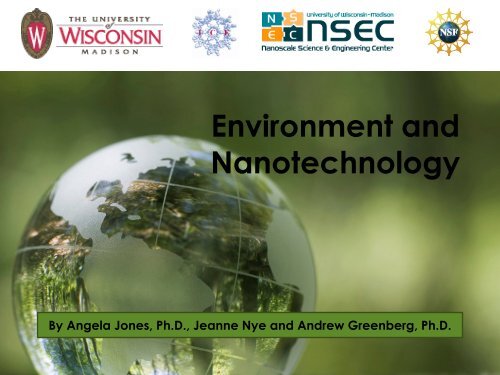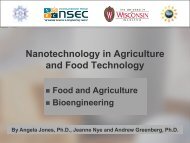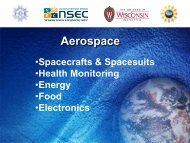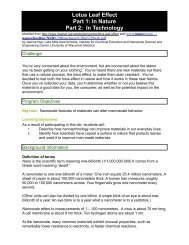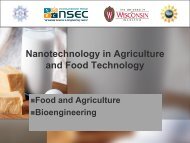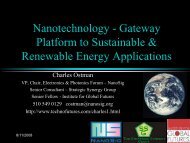Environment and Nanotechnology - Institute for Chemical Education
Environment and Nanotechnology - Institute for Chemical Education
Environment and Nanotechnology - Institute for Chemical Education
Create successful ePaper yourself
Turn your PDF publications into a flip-book with our unique Google optimized e-Paper software.
<strong>Environment</strong> <strong>and</strong><br />
<strong>Nanotechnology</strong><br />
By Angela Jones, Ph.D., Jeanne Nye <strong>and</strong> Andrew Greenberg, Ph.D.
From lakes to oceans, from air to<br />
soil, from <strong>for</strong>ests to deserts,<br />
from farms to cities.<br />
How can small science help us<br />
protect such a big beautiful<br />
world
What is nanotechnology<br />
A description -<br />
• <strong>Nanotechnology</strong> is the underst<strong>and</strong>ing <strong>and</strong> control of matter at<br />
dimensions between approximately 1 <strong>and</strong> 100 nanometers, or<br />
nanoscale.<br />
• Unusual physical, chemical, <strong>and</strong> biological properties can<br />
emerge in materials at the nanoscale. These properties may<br />
differ in important ways from the properties of bulk materials<br />
<strong>and</strong> single atoms or molecules.<br />
• Encompassing nanoscale science, engineering, <strong>and</strong><br />
technology, nanotechnology involves imaging, measuring,<br />
modeling, <strong>and</strong> manipulating matter at this length scale.<br />
Resource: www.nano.gov<br />
Note: This slide <strong>and</strong> the next 9 slides are the same <strong>for</strong> all research areas.
How BIG is nano<br />
Macrosize<br />
meters, decimeters, centimeters, millimeters<br />
Child<br />
H<strong>and</strong><br />
Pink y Finger<br />
Freckle<br />
Str<strong>and</strong> of Hair<br />
10 0 10 -1 10 -2 10 -3 10 -4<br />
A child is about 1 meter tall<br />
1 meter = 1,000,000,000 nm<br />
(1 billion nanometers)<br />
A h<strong>and</strong> is about 1 decimeter wide<br />
1 decimeter = 100,000,000 nm<br />
(100 million nanometers)<br />
A pinky finger is about<br />
1 centimeter wide<br />
1 centimeter = 10,000,000 nm<br />
(10 million nanometers)<br />
A freckle is about 1 millimeter wide<br />
1 millimeter = 1,000,000 nm<br />
(1 million nanometers)<br />
A hair is about one tenth of a<br />
millimeter wide<br />
0.1 millimeter = 100,000 nm<br />
(100 thous<strong>and</strong> nanometers)<br />
Microsize<br />
micrometers<br />
Nanosize<br />
nanometers<br />
Red Blood Cell<br />
Bacter ia<br />
Virus<br />
Cell Membrane<br />
Sugar M olecule<br />
Atom<br />
10 -5 10 -6 10 -7 10 -8 10 -9 10 -10<br />
A red blood cell is about<br />
10 micrometers wide<br />
10 micrometers = 10,000 nm<br />
(10 thous<strong>and</strong> nanometers)<br />
A bacterium is about<br />
1 micrometer wide<br />
1 micrometer = 1,000 nm<br />
(1 thous<strong>and</strong> nanometers)<br />
A viron is about one tenth<br />
of a micrometer wide<br />
0.1 micrometer = 100 nm<br />
(1 hundred nanometers)<br />
A cell membrane is about<br />
10 nanometers wide<br />
10 nanometers = 10 nm<br />
A sugar molecule is about<br />
1 nanometer wide<br />
1 nanometer = 1 nm<br />
An atom is about one tenth<br />
of a nanometer wide<br />
0.1 nanometer = 0.1 nm<br />
Created in 2008 by Sciencenter, Ithaca, NY, www.sciencenter.org<br />
Accompanying book available <strong>for</strong> purchase at www.lulu.com<br />
This material is based upon work supported by the National Science Foundation under Agreement No. ESI-0532536.<br />
Any opinions, findings, <strong>and</strong> conclusions or recommendations expressed in this material are those of the author(s)<br />
<strong>and</strong> do not necessarily reflect the views of the National Science Foundation.
Nanoscale<br />
1 nanometer =<br />
1 billionth (10 -9 ) of a<br />
meter<br />
D<br />
10 9 D<br />
a marble
Why do we care<br />
Things behave differently at this scale<br />
• Quantum mechanics plays a<br />
much more important role<br />
• For example,<br />
– A brick of gold is shiny <strong>and</strong><br />
“gold”-colored.<br />
– A vial of gold nanoparticles in<br />
solution can be a range of colors<br />
depending on the size of the<br />
nanoparticles.<br />
– This is because of a phenomenon<br />
know as quantum confinement.<br />
Suspensions of discrete (separated)<br />
gold nanoparticles in clear solution<br />
vary in color from pink to purple as<br />
the nanoparticle size gets bigger.<br />
Image source: “Causes of Color”, WebExhibits,<br />
http://www.webexhibits.org/causesofcolor/9.html
Why else do we care<br />
This is the scale of biological processes<br />
• Human cells <strong>and</strong> bacteria have<br />
diameters around 1-10<br />
micrometers<br />
BUT<br />
• Cellular machinery is on the<br />
nanoscale<br />
– Diameter of DNA is ~2<br />
nanometers<br />
– Hemoglobin, the protein that<br />
carries oxygen through the<br />
body, is 5.5 nanometers in<br />
diameter<br />
Structure of DNA<br />
PDB ID: 1BNA<br />
Structure of hemoglobin<br />
PDB ID: 1BUW
One more reason: surface area<br />
Another reason nanomaterials behave differently from bulk materials of<br />
the same chemical is because of surface area – or the area of an object<br />
that is an exposed surface.<br />
Volume<br />
(in cubic meters):<br />
Surface Area<br />
(in square meters):<br />
1 m<br />
For this cube, each<br />
edge is 1 meter in<br />
length.<br />
1 m<br />
1 m<br />
For these<br />
cubes,<br />
each edge<br />
is 0.1<br />
meters in<br />
length, but<br />
there are<br />
1000<br />
cubes.<br />
1m X 1m X 1m = 1 m 3 (0.1m X 0.1m X 0.1m) X 1000 cubes = 1 m 3<br />
(1m X 1m) X 6 sides = 6 m 2 (0.1m X 0.1m) X 6 sides X 1000 cubes = 60 m 2
Surface Area <strong>and</strong> Reactions<br />
• This increased surface area allows chemical reactions to<br />
go much faster.<br />
• Think about it this way:<br />
Which dissolves faster in your coffee or tea, a sugar<br />
cube or a teaspoon of granulated sugar<br />
Answer:<br />
Granulated<br />
sugar
Nano-enabled Consumer Products<br />
As of the March 10, 2011, there are over 1300<br />
consumer products around the world that are<br />
manufacturer-identified as nanotechnologybased.<br />
• Touch screens (iPhone)• Bicycles<br />
• Sunscreens • Fabric<br />
• Cosmetics<br />
• Computer memory<br />
• Tennis rackets • Many more…<br />
These products are here, ready to buy today!<br />
Resources:<br />
The Project on Emerging Nanotechnologies website: http://www.nanotechproject.org/
Activity Description<br />
• You have been assigned an area of nanotechnology research<br />
to support.<br />
• Go through this presentation <strong>and</strong> any other credible sources<br />
to identify three benefits of research in nanotechnology<br />
toward your area of interest <strong>and</strong> up to three potential risks<br />
you perceive in your area of interest.<br />
• As a group, we will weigh the risks <strong>and</strong> benefits of each area<br />
to decide how much of our federal nanotechnology budget<br />
should go to each research area.
Disclaimer:<br />
this is a contrived scenario<br />
• There are no federal nanotechnology budget cuts<br />
– $1.7 billion estimated <strong>for</strong> FY2012 (fiscal year 2012)<br />
– Increased investment proposed <strong>for</strong> FY2013 (nearly $1.8 billion)<br />
• Nanoscale Science, Engineering <strong>and</strong> Technology (NSET) subcommittee of<br />
the National Science <strong>and</strong> Technology Council's Committee on Technology<br />
is an actual government entity<br />
– Composed of representatives from 25 federal agencies (NIH, DOE, DOD, etc.)<br />
– Purpose is to coordinate planning, budgeting, <strong>and</strong> implementation of the<br />
National <strong>Nanotechnology</strong> Initiative (NNI)<br />
– These representatives work together to create an integrated federal program.<br />
• Actual nano “budget” is different from what is proposed in this activity<br />
– Actual “budget” is given as a supplement to the President’s 2013 Budget<br />
Request submitted to Congress<br />
– It represents the sum of the investment in nanotechnology <strong>and</strong> nanoscience<br />
planned <strong>for</strong> 2013 by federal agencies<br />
– The agencies submit how much they are planning to spend on nanoscience<br />
– In the activity scenario, we’re doing the opposite of what the actual NNI<br />
Budget represents in that we’re distributing a pre-determined amount<br />
amongst these research areas.<br />
Resources:<br />
NNI Budget website: http://www.nano.gov/about-nni/what/funding
Green Science<br />
In this presentation, you will learn about<br />
some of the developments in<br />
nanotechnology in cleaning up the<br />
environment.
Consider the following when learning about<br />
these developments:<br />
1. Might these nanotechnology developments<br />
infringe on human rights to privacy <strong>and</strong><br />
freedom<br />
2. Is it safe <strong>for</strong> me Is it safe <strong>for</strong> others<br />
3. Could the use of this nanotechnology<br />
development have unwanted <strong>and</strong> negative<br />
environmental effects<br />
4. What economic impact could the use of this<br />
nanotechnology development have on<br />
producers, consumers, <strong>and</strong> other industries<br />
Might they be negative or positive
What About Your Rights<br />
If so, are these<br />
developments more<br />
important than<br />
• Your privacy<br />
• Your rights as a citizen<br />
• Your rights as a human<br />
being<br />
Are the answers<br />
somewhere in between<br />
Image source: http://www.info4security.com/Pictures/web/w/v/m/iStock_Law.jpg
Links to outside sources<br />
• Within this presentation will be many underlined<br />
words. If you click on the underlined text, your<br />
browser will take you to other websites, videos, or<br />
other resources to learn more about what is on the<br />
slide.<br />
• These links are chosen to give you additional<br />
in<strong>for</strong>mation, but these presentations can st<strong>and</strong><br />
alone. It is unnecessary to go to the links <strong>for</strong> the<br />
purpose of this activity.<br />
• We try to make sure the links are active, but given<br />
the ever-changing nature of the internet, you might<br />
find a few that take you to a location that is no<br />
longer active. Please let the facilitator know if you<br />
find an inactive link.
<strong>Environment</strong><br />
• <strong>Nanotechnology</strong> is making significant<br />
improvements in technologies <strong>for</strong> protecting the<br />
environment.<br />
• Nanoscale devices are being used <strong>for</strong> enhanced<br />
sensing, treating <strong>and</strong> remediating environmental<br />
contaminants.<br />
• Someday we may be able to prevent pollution with<br />
the help of nanotechnology.<br />
• On the other h<strong>and</strong>, nanotechnology's unique<br />
characteristics may also lead to un<strong>for</strong>eseen<br />
environmental problems.<br />
Resource<br />
“<strong>Nanotechnology</strong> Basic In<strong>for</strong>mation,” United States <strong>Environment</strong>al Protection Agency,<br />
http://www.epa.gov/ncer/nano/questions/index.html
Nanosensors <strong>and</strong> the<br />
environment<br />
Nanosensors can be used to detect <strong>and</strong> track pathogens (germs),<br />
contaminants, nutrients, environmental characteristics (light/dark,<br />
hot/cold, wet/dry), heavy metals, particulates, <strong>and</strong> allergens. [1]<br />
• Scientists at Pacific Northwest National<br />
Laboratory (PNNL), in partnership with<br />
PANalytical B.V., developed Functionalized<br />
Nanoporous Thin Films (FNTF). [2]<br />
• The technology is a low-cost, highly-selective<br />
means <strong>for</strong> detecting heavy metals in<br />
aqueous (water) environments. [2]<br />
• It allows testing <strong>for</strong> virtually every heavy<br />
metal (including mercury, lead, <strong>and</strong><br />
cadmium) with potential to negatively affect<br />
human health <strong>and</strong> the environment, <strong>and</strong><br />
increases sensitivity by more than a thous<strong>and</strong><br />
times the previous capability. [2]<br />
Resources [1] “<strong>Nanotechnology</strong>,” National <strong>Institute</strong> of Food <strong>and</strong> Agriculture,<br />
http://www.nifa.usda.gov/ProgViewOverview.cfmprnum=16500<br />
[2] “Coating helps increase water testing sensitivity by one thous<strong>and</strong> times ,” PNNL,<br />
http://www.pnl.gov/business/stories.aspx#story21<br />
Artistic rendering of the<br />
Functionalized Nanoporous Thin<br />
Films, Image credit: PNNL
nanoDESI<br />
Cars, fires, industrial manufacturing plants, <strong>and</strong> others produce a<br />
complex variety of chemicals in the air, often to the detriment of the<br />
environment <strong>and</strong> our health.<br />
• Traditional methods <strong>for</strong> determining the<br />
chemical makeup of the air around us<br />
requires expensive equipment <strong>and</strong> experts<br />
<strong>for</strong> preparation of the sample to be tested.<br />
• Researchers at the PNNL developed the<br />
nanoDESI to make it faster <strong>and</strong> easier to<br />
make those measurements.<br />
• For analysis, the sample is first dissolved into<br />
a liquid (called a solvent), then the<br />
dissolved sample is made into an aerosol of<br />
ions by nano-electrospray ionization.<br />
• Now that the sample is aerosolized, the<br />
particulate can be analyzed using a high<br />
resolution mass spectrometer.<br />
Created at PNNL, the nanoDESI<br />
requires no sample preparation <strong>and</strong><br />
provides a reliable, simple way to<br />
introduce samples into a mass<br />
spectrometer <strong>for</strong> detailed analysis.<br />
Photo Credit: PNNL<br />
Resources [1] “Scientific Stimulus Produces Results: A cascade of opportunities are unleashed by one instrument, a novel idea, <strong>and</strong> EMSL's<br />
intramural program,” EMSL, http://www.emsl.pnl.gov/news/viewArticle.jsparticleId=147<br />
[2] “New Technique Provides Sensitive Analysis of Atmospheric Particles,” PNNL,<br />
http://www.pnl.gov/science/highlights/highlight.aspid=813
<strong>Environment</strong>al Cleanup<br />
“<strong>Environment</strong>al remediation deals with the removal of pollution or contaminants<br />
from environmental media such as soil, groundwater, sediment, or surface water<br />
<strong>for</strong> the general protection of human health <strong>and</strong> the environment.” [1]<br />
Nanoscience is making great strides in remediation research.<br />
• Scientists from Pacific Northwest National<br />
Laboratory (PNNL), the University of<br />
Washington, <strong>and</strong> Oregon Health & Science<br />
University developed superparamagnetic<br />
nanoparticles capable of absorbing heavymetals.<br />
[2, 3]<br />
• The magnetic nanoparticles are decorated<br />
with chemicals that can capture metal ions.<br />
[2, 3]<br />
• They tested their nanoparticles in river water<br />
spiked with seven environmentally relevant<br />
heavy-metals. [2, 3]<br />
Cartoon of magnetic nanoparticles<br />
capable of absorbing heavy-metals from<br />
water sources. Image credit: EMSL<br />
Resources [1] “<strong>Environment</strong>al remediation,” Wikipedia, http://en.wikipedia.org/wiki/<strong>Environment</strong>al_remediation<br />
[2] “A Better Drop to Drink: Method <strong>for</strong> creating nanoparticle heavy-metal sorbents saves water—literally,” <strong>Environment</strong>al<br />
Molecular Sciences Laboratory (EMSL) http://www.emsl.pnl.gov/root/news/viewArticle.jsparticleId=118<br />
[3] Warner, C. L., et al. "High-Per<strong>for</strong>mance, Superparamagnetic, Nanoparticle-Based Heavy Metal Sorbents <strong>for</strong> Removal of<br />
Contaminants from Natural Waters." Chemsuschem 3.6 (2010): 749-57.
<strong>Nanotechnology</strong> <strong>and</strong> Oil Spills<br />
Deepwater Horizon oil rig exploded in the Gulf of Mexico on April 20,<br />
2010. What followed was an 87 day underwater leak of oil that wreaked<br />
havoc to aquatic life <strong>and</strong> human life. There are many proposed ways<br />
that nanotechnology can be applied to oil spill clean up, many of which<br />
are outlined at this link. Below is just one of many.<br />
• Researchers at MIT developed a mat of<br />
nanowires that can absorb up to 20 times<br />
its weight in oil.<br />
• After cleaning up oil from water, the oil<br />
can then be recovered by heating the<br />
membrane above the boiling point of the<br />
oil so that it evaporates.<br />
• The vapor can then be condensed back<br />
into liquid, <strong>and</strong> the oil AND the nanowire<br />
membrane can be used again!<br />
Top: Swatch of oil-absorbing nanowire<br />
mesh. Bottom: Scanning electron<br />
micrograph of the nanowire mesh.<br />
Photo credit: Francesco Stellacci, MIT,<br />
<strong>and</strong> Nature <strong>Nanotechnology</strong><br />
Resources [1] Thomson, E., “MIT develops a 'paper towel' <strong>for</strong> oil spills,” MIT News, http://web.mit.edu/newsoffice/2008/oil-paper-0530.html<br />
[2] Yuan, J. K., et al. "Superwetting Nanowire Membranes <strong>for</strong> Selective Absorption." Nature <strong>Nanotechnology</strong> 3.6 (2008): 332-36.
<strong>Nanotechnology</strong> <strong>and</strong> Air<br />
Pollution<br />
• Researchers at PNNL have also<br />
developed new materials that<br />
inexpensively capture carbon dioxide<br />
(CO 2 ) efficiently <strong>and</strong> selectively.<br />
• They’ve used materials based on metalorganic<br />
frameworks (MOF) to make tiny<br />
“cages” capable of capturing the CO 2 .<br />
• These MOFs have 2-3 times the CO 2<br />
capacity compared to conventional<br />
sorbents.<br />
• Releasing the CO 2 from the MOF<br />
requires just the pull of a vacuum, while<br />
other technologies require heating up to<br />
release the gas.<br />
• The CO 2 can then be pumped deep into<br />
the Earth where it becomes stable in the<br />
<strong>for</strong>m of carbonate minerals.<br />
Transmission electron micrograph of<br />
PNNL’s MOF nano-crystals 40<br />
nanometers in size. In the insert in the<br />
upper left-h<strong>and</strong> corner, you can also<br />
see the uni<strong>for</strong>mity of the nanopores that<br />
capture the CO 2 . Image Credit: PNNL.<br />
Resources [1] Thallpally, D. <strong>and</strong> P. McGrail, “Molecularly organized nanomaterials <strong>for</strong> carbon dioxide capture,” Pacific Northwest National<br />
Laboratory ,” http://www.pnl.gov/nano/research/pdf/mof_flier_12-02-2010.pdf
Fossil Fuel Consumption<br />
According to the World Coal <strong>Institute</strong>,<br />
“At current production levels coal will be available <strong>for</strong><br />
at least the next 119 years - compared to 46 years <strong>for</strong> oil<br />
<strong>and</strong> 63 years <strong>for</strong> [natural] gas.” [1]<br />
119 years 46 years 63 years<br />
In the words of Thomas Edison in 1931,<br />
“I’d put my money on the sun <strong>and</strong> solar energy. What a source of power! I<br />
hope we don’t have to wait until oil <strong>and</strong> coal run out be<strong>for</strong>e we tackle<br />
that.” [2, 3]<br />
Resources:<br />
[1] http://www.worldcoal.org/coal-society/coal-energy-security/<br />
[2] Newton, J. Uncommon Friends: Life With Thomas Edison, Henry Ford, Harvey Firestone, Alexis Carrel, <strong>and</strong> Charles Lindbergh. New<br />
York: Harcourt, 1987.<br />
[3] Abbott, D. “Keeping the Energy Debate Clean: How Do We Supply the World’s Energy Needs” Proceedings of the IEEE. Volume
Solar Energy<br />
• The world population currently consumes<br />
energy at a rate of 15 terawatts (TW).<br />
• After accounting <strong>for</strong> solar energy that is<br />
reflected back into space <strong>and</strong> absorbed by<br />
clouds, we are left with 85 petawatts (PW) or<br />
85,000 TW available <strong>for</strong> solar collection on<br />
Earth.<br />
• If we consider only the solar power that hits<br />
desert regions of the world, we still get 7,650<br />
TW. That’s over 500 times our current world<br />
consumption!<br />
Resource: Abbott, D. “Keeping the Energy Debate Clean: How Do We Supply the World’s Energy Needs” Proceedings of<br />
the IEEE. Volume 98, Issue 1: 43-66.<br />
Note: These values are available power. This does not account <strong>for</strong> energy conversion efficiency of solar cells or solar<br />
collectors.
<strong>Nanotechnology</strong> is Making Solar<br />
Power Cheaper<br />
One example is the use of organic photovoltaic<br />
cells (OPV) instead of the more common silicon<br />
crystal solar cells.<br />
• Made from light-sensitive polymers [1]<br />
• These polymers can be dissolved in liquids,<br />
<strong>and</strong> so they can be used in screen printing,<br />
inkjet printing, <strong>and</strong> spray deposition (like spray<br />
paint) which make manufacturing materials<br />
using high-throughput processes like roll-to-roll<br />
printing (think newspaper printing) possible,<br />
<strong>and</strong> this can drive the cost down [2].<br />
• Though conversion efficiency is typically on<br />
the order of 5% [1], scientists are working on<br />
improving that through controlling nanoscale<br />
morphology [2].<br />
Resources: [1] Jacoby, M. "The Power of Plastic." <strong>Chemical</strong> & Engineering News 88.34 (2010): 12-16.<br />
[2] Mayer, A. C., et al. "Polymer-Based Solar Cells." Materials Today 10.11 (2007): 28-33.
Energy Generation <strong>and</strong><br />
Storage<br />
• There are currently many nanotechnology<br />
based projects in the area of energy<br />
generation <strong>and</strong> storage.<br />
– Af<strong>for</strong>dable solar cells (like in the previous slides)<br />
– Better rechargeable batteries<br />
– Hydrogen storage <strong>for</strong> hydrogen fuel cells<br />
– More durable gas turbines<br />
– Cost effective <strong>and</strong> sustainable biofuel<br />
production<br />
– Many, many more…<br />
• For more, go to the Energy presentation on<br />
this website.
Green Manufacturing<br />
According to the EPA,<br />
“<strong>Nanotechnology</strong> offers the possibility of<br />
changing the manufacturing process in<br />
2 ways:<br />
• Incorporating nanotechnology <strong>for</strong><br />
efficient, controlled manufacturing<br />
[that] would drastically reduce<br />
waste products<br />
• The use of nanomaterials as<br />
catalysts <strong>for</strong> greater efficiency in<br />
current manufacturing processes by<br />
minimizing or eliminating the use of<br />
toxic materials <strong>and</strong> the generation<br />
of undesirable by-products <strong>and</strong><br />
effluents” [1]<br />
Waste<br />
Resources [1] “<strong>Nanotechnology</strong>: Green Manufacturing ,” EPA, http://www.epa.gov/ncer/nano/research/nano_green.html
Nanocatalysts<br />
Nanocatalysts will process waste into food, feed, industrial chemicals,<br />
biofuels <strong>and</strong> energy. [1]<br />
Catalysts are molecules that can speed up a chemical reactions, <strong>and</strong> the<br />
increased surface area of nanocatalysts lead to even faster reactions!<br />
• In a collaboration between Rice University<br />
<strong>and</strong> Lehigh University, researchers have<br />
developed a nanocatalysts that will make<br />
the oil refining process more efficient <strong>and</strong><br />
better <strong>for</strong> the environment. [2, 3]<br />
• Rice University Prof. Michael Wong says the<br />
following about his discovery, “Improving a<br />
catalyst can… make the chemical process<br />
more environmentally friendly. Knock those<br />
things out, <strong>and</strong> they gain efficiencies <strong>and</strong><br />
save money.” [2]<br />
Resources [1] “<strong>Nanotechnology</strong>,” National <strong>Institute</strong> of Food <strong>and</strong> Agriculture,<br />
http://www.nifa.usda.gov/ProgViewOverview.cfmprnum=16500<br />
This is a scanning transmission<br />
electron microscope (STEM) image of<br />
the nanocatalyst (green circles) on<br />
zirconia support. The other circles<br />
show the less-active <strong>for</strong>ms of the<br />
nanocatalyst. Photo Credit: Wu<br />
Zhou/Lehigh University via PhysOrg.<br />
[2] Williams, M., “Nanocatalyst is a gas: Rice U. <strong>for</strong>mula could make fuel manufacturing better, greener,” Rice News & Media<br />
Relations, http://www.media.rice.edu/media/NewsBot.aspMODE=VIEW&ID=14752<br />
[3] Soultanidis, N., et al. "Relating N-Pentane Isomerization Activity to the Tungsten Surface Density of Wox/Zgo(2)." Journal of the
So, Isn’t This Great News<br />
To summarize <strong>and</strong> elaborate on positive points<br />
already made which promote the use of<br />
nanoparticles in the environment -<br />
1. Nanosensors can be used to identify pollutants<br />
faster <strong>and</strong> cheaper.<br />
2. Nanocatalysts <strong>and</strong> nanoparticles can be used to<br />
clean up pollution in the ground, air or water.<br />
3. Nanoscience is making great strides in not only<br />
making the manufacturing <strong>and</strong> use of fossil fuels<br />
more environmentally friendly, but also in<br />
advancing alternative energy sources like solar<br />
energy, batteries, fuel cells, <strong>and</strong> biofuels.
But…<br />
• What are there unintended consequences to the<br />
environment in using nanotechnology They could<br />
cause unexpected <strong>and</strong> dangerous problems in<br />
plants, animals or the environment.<br />
• What is the cost to the environment when we<br />
manufacture <strong>and</strong> use nanomaterials <strong>and</strong><br />
techniques
Nanomanufacturing problems<br />
Researchers at the University of Illinois at<br />
Chicago (ref. 1) have found that some<br />
nanomanufacturing processes are expensive<br />
<strong>and</strong> not very environmentally friendly:<br />
• Strict purity needed <strong>for</strong> starting materials<br />
• Repetitive processing steps<br />
• Processing requires extreme environments<br />
– High temperatures<br />
– Cryogenics (extremely cold)<br />
– Cleanrooms<br />
• Use of toxic chemicals <strong>and</strong> solvents<br />
• Generation of greenhouse gases<br />
• High usage of energy <strong>and</strong> water<br />
• Low yield compared to starting materials<br />
NASA’s Microsystems Fabrication<br />
Laboratory Cleanroom. Photo<br />
credit: Marvin Smith/ NASA<br />
As a result, the EPA is pushing<br />
<strong>for</strong> research in improved<br />
nanomanufacturing<br />
processes that are more<br />
environmentally benign. [2]<br />
Resources [1] Sengul, H., T. L. Theis, <strong>and</strong> S. Ghosh. "Toward Sustainable Nanoproducts: An Overview of Nanomanufacturing Methods."<br />
Journal of Industrial Ecology 12.3 (2008): 329-59.<br />
http://www.uic.edu/depts/ovcr/iesp/Publications/Faculty%20Publications/Theis/Theis_Toward%20Sustainable%20Nanoproducts<br />
.pdf<br />
[2] Savage, N., “Research Advancing Green Manufacturing of <strong>Nanotechnology</strong> Products,” EPA,<br />
http://www.epa.gov/nanoscience/quickfinder/green.htm
Green Nanoscience<br />
• Jim Hutchinson, chemistry professor at the<br />
University of Oregon, is leading the way to push<br />
using principals of green chemistry as<br />
nanoscience develops. [1]<br />
• He is director of Safer Nanomaterials <strong>and</strong><br />
Nanomanufacturing Initiative, the goal of which<br />
is to “develop new nanomaterials <strong>and</strong><br />
nanomanufacturing approaches that offer a<br />
high level of per<strong>for</strong>mance, yet pose minimal<br />
harm to human health or the environment.” [2]<br />
• Go to this link to watch a video from<br />
ScienCentral where Prof. Hutchinson describes<br />
this work.<br />
N<br />
A<br />
N<br />
Resources [1] “Hutchinson Advocates <strong>for</strong> Green Nano,” University of Oregon CAScade, http://cascade.uoregon.edu/fall2008/naturalsciences/hutchinson-advocates-<strong>for</strong>-green/<br />
[2] Safer Nanomaterials <strong>and</strong> Nanomanufacturing Initiative website, http://www.greennano.org/
<strong>Environment</strong> Websites<br />
These websites can help you find more in<strong>for</strong>mation on nanotechnology<br />
in the environment. The last link connects you to general nanoscience<br />
sites.<br />
• U.S. <strong>Environment</strong>al Protection Agency Nanoscience website<br />
http://www.epa.gov/ncer/nano/index.html<br />
• USDA National <strong>Institute</strong> of Food <strong>and</strong> Agriculture <strong>Nanotechnology</strong><br />
website<br />
http://www.nifa.usda.gov/ProgViewOverview.cfmprnum=16500<br />
• Pacific Northwest National Laboratory Nanoscience <strong>and</strong> the<br />
<strong>Environment</strong> website http://www.pnl.gov/nano/environment.stm<br />
• Brochure on Nanoscience at the <strong>Environment</strong>al Molecular Sciences<br />
Laboratory (EMSL)<br />
http://www.emsl.pnl.gov/root/publications/brochures/nanoscience_<br />
at_EMSL.pdf<br />
• A Presentation from Cynthia Folsom Murphy <strong>and</strong> David Allen,<br />
University of Texas, October 4, 2004<br />
• Numerous nanoscience sites are linked here: Websites
Nano-enabled consumer<br />
products<br />
To learn more about nano-enabled consumer products in all areas of<br />
research visit the Project on Emerging Nanotechnologies<br />
• Established in April 2005 as a partnership between the Woodrow<br />
Wilson International Center <strong>for</strong> Scholars <strong>and</strong> the Pew Charitable<br />
Trusts<br />
• “The Project is dedicated to helping ensure that as<br />
nanotechnologies advance, possible risks are minimized, public<br />
<strong>and</strong> consumer engagement remains strong, <strong>and</strong> the potential<br />
benefits of these new technologies are realized.”<br />
• Their website includes news <strong>and</strong> publications about issues with<br />
nanotechnology.<br />
• It also includes inventories of consumer products that are<br />
manufacturer-identified as nanotechnology based, <strong>and</strong> as of the<br />
March 10, 2011 update, there are over 1300 products around the<br />
world.<br />
Resources:<br />
The Project on Emerging Nanotechnologies website: http://www.nanotechproject.org/
More on the website<br />
If time allows, return to the main website<br />
<strong>and</strong> watch some of the videos that<br />
provide “expert testimony” in the area of<br />
nanotechnology <strong>and</strong> the environment.<br />
Click here


